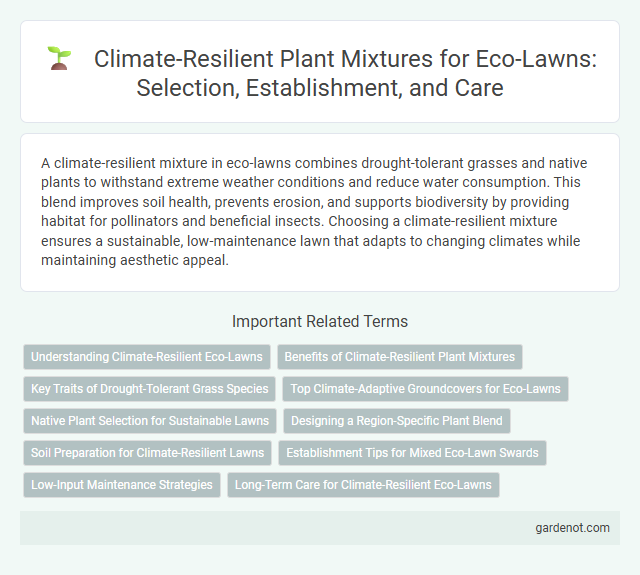A climate-resilient mixture in eco-lawns combines drought-tolerant grasses and native plants to withstand extreme weather conditions and reduce water consumption. This blend improves soil health, prevents erosion, and supports biodiversity by providing habitat for pollinators and beneficial insects. Choosing a climate-resilient mixture ensures a sustainable, low-maintenance lawn that adapts to changing climates while maintaining aesthetic appeal.
Understanding Climate-Resilient Eco-Lawns
Climate-resilient eco-lawn mixtures combine drought-tolerant grasses, native wildflowers, and deep-rooted perennials to withstand extreme weather patterns and reduce water consumption. These blends enhance soil health by improving aeration and supporting beneficial microbial activity, leading to increased resilience against temperature fluctuations and prolonged dry spells. Selecting region-specific species ensures optimal growth and sustainability, promoting long-term environmental benefits and reducing maintenance requirements.
Benefits of Climate-Resilient Plant Mixtures
Climate-resilient plant mixtures enhance eco-lawns by improving drought tolerance, reducing water usage, and sustaining vibrant greenery under extreme weather conditions. These mixtures support soil health through increased biodiversity, promoting natural pest resistance and reducing the need for chemical interventions. Integrating climate-resilient species fosters long-term lawn sustainability, ensuring adaptability to evolving climate patterns.
Key Traits of Drought-Tolerant Grass Species
Climate-resilient eco-lawn mixtures incorporate drought-tolerant grass species such as buffalo grass, blue grama, and fine fescues, which exhibit deep root systems and efficient water usage. These grasses possess key traits like high evapotranspiration regulation, low water requirement, and heat tolerance, ensuring sustainability during prolonged dry periods. Integrating these species enhances soil moisture retention, reduces irrigation needs, and supports eco-friendly landscaping in arid and semi-arid climates.
Top Climate-Adaptive Groundcovers for Eco-Lawns
Climate-resilient mixtures for eco-lawns feature top climate-adaptive groundcovers such as native buffalo grass, creeping thyme, and clover, which thrive under drought and temperature fluctuations. These species improve soil health, reduce water usage, and enhance biodiversity by supporting pollinators and native insects. Selecting mix components based on local climate data ensures eco-lawns withstand extreme weather while maintaining aesthetic and ecological functions.
Native Plant Selection for Sustainable Lawns
Selecting native plant species for eco-lawns enhances climate resilience by promoting deep root systems that improve soil structure and water retention. These native grasses and wildflowers are naturally adapted to local environmental conditions, reducing the need for irrigation, fertilizers, and pesticides. Integrating a diverse mix of drought-tolerant and shade-capable native plants supports biodiversity and long-term lawn sustainability.
Designing a Region-Specific Plant Blend
Climate-resilient eco-lawn mixtures prioritize designing region-specific plant blends that enhance drought tolerance and reduce the need for supplemental watering. Incorporating native grasses and drought-resistant species such as fine fescues and buffalo grass optimizes soil retention and biodiversity. Tailoring seed blends to local climate patterns ensures sustainable growth and long-term environmental benefits.
Soil Preparation for Climate-Resilient Lawns
Proper soil preparation enhances water retention and nutrient availability essential for climate-resilient lawns. Incorporating organic matter and aerating compacted soil improves root growth and supports drought-tolerant grass species. Selecting a soil mixture with balanced pH and adequate drainage ensures long-term lawn sustainability under extreme weather conditions.
Establishment Tips for Mixed Eco-Lawn Swards
Climate-resilient eco-lawn mixtures combine drought-tolerant grasses such as fescues and fine-leaved creeping red fescue with native wildflowers to enhance biodiversity and withstand extreme weather. Optimal establishment requires loosening soil to a depth of 10 cm, consistent watering during the first six weeks, and avoiding heavy foot traffic to promote deep root development. Applying a slow-release, low-nitrogen fertilizer improves nutrient uptake while minimizing environmental impact in mixed eco-lawn swards.
Low-Input Maintenance Strategies
Climate-resilient mixtures in eco-lawns incorporate drought-tolerant grasses and native species, reducing the need for irrigation and chemical fertilizers. These blends enhance soil health and improve water retention, supporting sustainable growth under fluctuating climate conditions. Low-input maintenance strategies include minimal mowing, organic mulching, and integrated pest management to sustain a resilient, eco-friendly lawn ecosystem.
Long-Term Care for Climate-Resilient Eco-Lawns
Climate-resilient mixtures for eco-lawns incorporate drought-tolerant grass species such as fescues, bluegrasses, and clovers that enhance water retention and reduce irrigation needs. Effective long-term care emphasizes deep, infrequent watering, aeration to improve soil structure, and minimal chemical inputs to maintain soil health and biodiversity. Regular mowing at higher cut heights encourages deep root growth, increasing the lawn's resilience to climate stressors and temperature fluctuations.
Climate-resilient mixture Infographic

 gardenot.com
gardenot.com